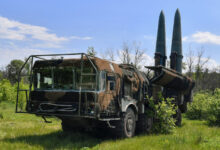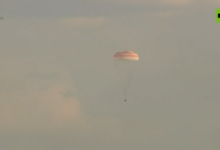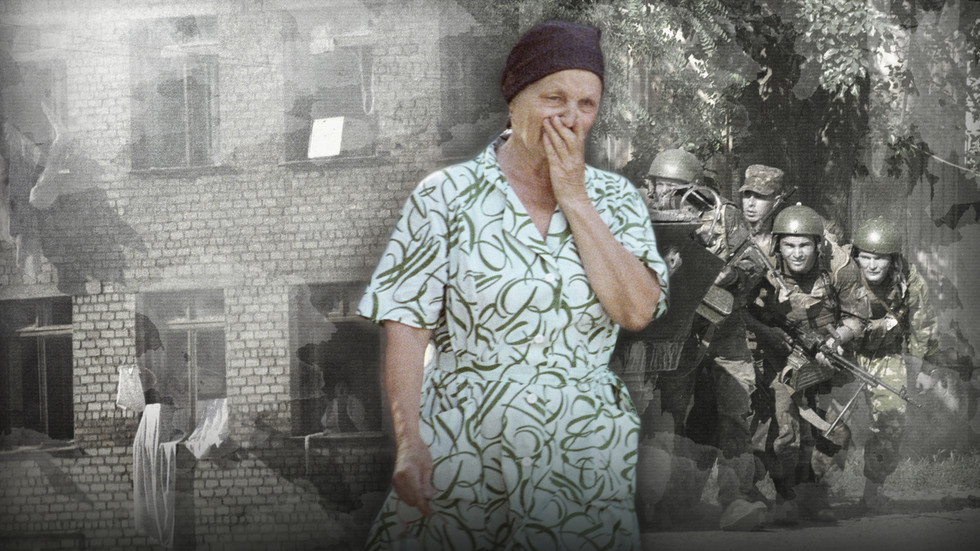
Chechen separatists captured a hospital in southern Russia. They managed to get what they wanted and get away.

This feature was first published on February 12, 2022 and is being published again to mark the occasion of the upcoming anniversary of this tragic event.
Terrorism – plane hijacking and hostage crises – was not a concept entirely unfamiliar to the USSR, but it was post-Soviet Russia where terrorism became an oppressively grim backdrop to everyday life. While in the USSR, terrorist attacks had been perpetuated by ordinary criminals, the wars that took place in former Soviet countries gave rise to separatists and Islamist zealots. The 1995 Budyonnovsk tragedy, in which Chechen terrorists took an entire hospital hostage, left many wounded and dead – but it also signified a fateful change. Back then, the government agreed to the terrorists’ terms, which had far-reaching strategic consequences both for Russia and for militants in the Caucasus.
By summer 1995, the war in Chechnya had been raging for six months. Following the bloody battle for the capital, Grozny, separatist leader Dzhokhar Dudayev’s troops started withdrawing to the mountainous southern part of the republic. Both sides suffered heavy losses, but unlike the Chechens, the Russian Army could get new blood to swell the ranks. Gradually, the Russian troops forced the militants to retreat deeper and deeper into the mountains. Dudayev’s men were not a real army – small groups of fighters would go home and wait for new developments. There was no way to mobilize and house reserves. Many militants agreed that they were facing an overwhelming defeat if the 1995 campaign were to go on. Dudayev needed something to turn things around – and he got it.
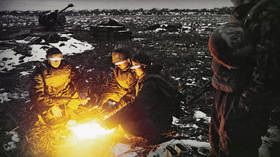
Read more
It was the warlords who came up with a plan – or rather, their leader, Shamil Basayev, who soon became as notorious in Russia as Osama bin Laden later would in the US. Basayev had been a key figure among the Chechen warlords even before the war. He first came into the limelight in 1991, when the Chechen separatist movement was starting to gain momentum and Dudayev declared the republic’s independence. The then-unknown Basayev quickly realized what chances the ensuing anarchy had to offer. To ensure a leadership position, he committed his first terrorist attack, hijacking a plane at Mineralnye Vody Airport and flying it to Turkey. Instead of asking for ransom like an ordinary criminal, Basayev demanded a press conference and showed off in front of the media before returning to the turbulent Chechnya. No one died then, but the terrorist realized the power that graphic violence – combined with media coverage – had in influencing public opinion.
When the war began, Basayev had a big group of militants under his command. It suffered heavy losses in the battle for Grozny but remained fairly large and well-armed. People like Basayev had nothing to lose. Rank-and-file militants could run back home hoping for amnesty, but for their leaders, that was not an option. With an act of terrorism under his belt, it was Basayev who had experience with these things, and so he came up with the idea that could save Dudayev and everyone else – taking hostages and presenting the Chechen leaders’ political demands from behind human shields. This, however, meant that the militants had to discard their façade as freedom fighters – along with their humanity.
The terrorists’ intended target was Mineralnye Vody Airport. Basayev, who had already carried out one terrorist attack there, knew the airport and the city well. It’s a popular tourist destination, teeming with people in the summer. The attack was to be carried out by a large group – 195 people armed with not only assault rifles, but also machine guns and anti-tank grenade launchers. The operation involved snipers, landmines, and explosives, making this the kind of terrorist attack that did not follow the usual pattern in which a few criminals take control of a plane or a bus. Fitting everyone in one car was out of the question, of course, so Basayev organized them in a fake army convoy comprised of several trucks and cars. The convoy followed a car painted to pass for a police vehicle, with the militants inside wearing police uniforms. One of them had been an actual policeman before the war.
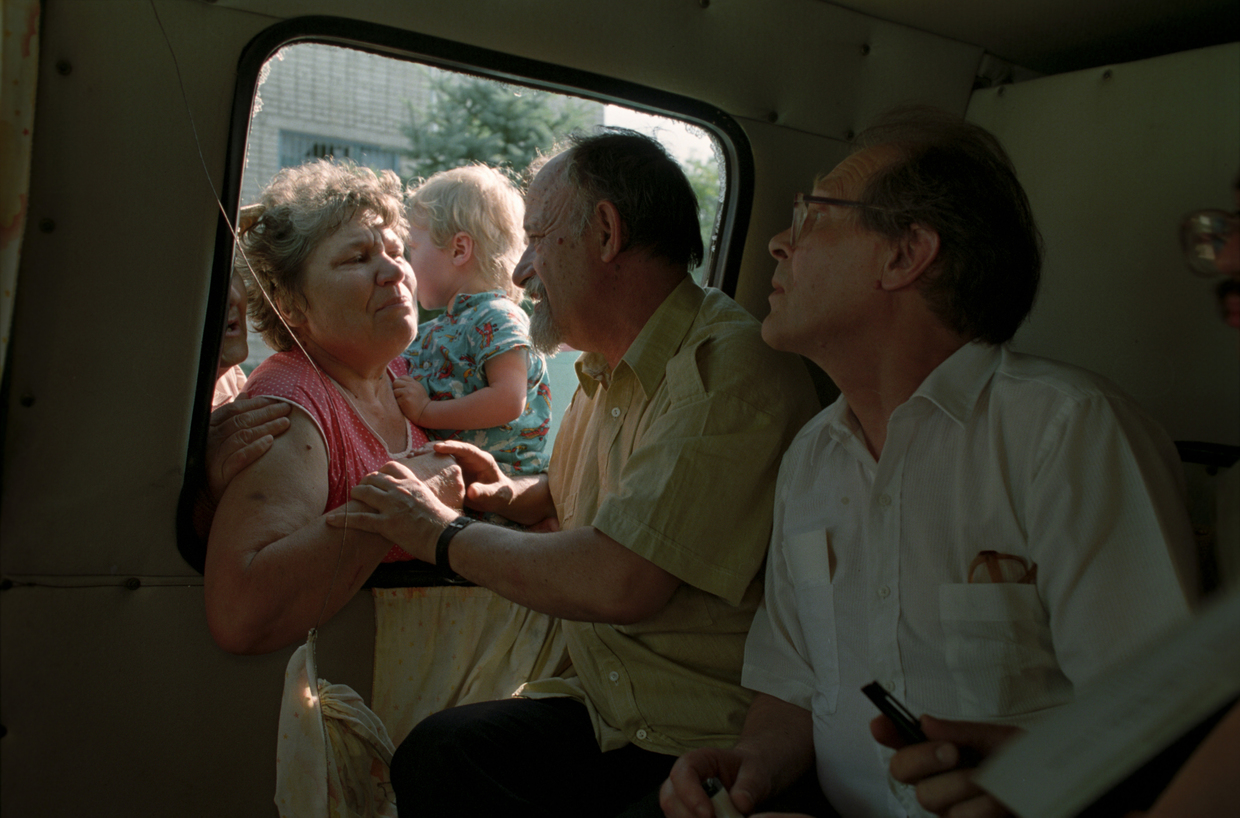
A terrorist attack on the Russian city of Buddyonovsk and hostage siege at a hospital. © Sputnik / Yuriy Tutov
The convoy set out late on June 13, on a countryside route specifically chosen to avoid any checkpoints. Chechnya was not a well-isolated theater of war, so crossing into Stavropol Region was easy. At the first police checkpoint, Basayev said the convoy was transporting ‘Cargo 200’ – code word for casualties – from Chechnya. The simple lie seemed plausible, so it worked.
On the way to their destination, the convoy was supposed to pass a town called Budyonnovsk. Established in the 18th century, Budyonnovsk went through cycles of growth and stagnation. In 1995, it was a small provincial town of 60,000 people – a quiet place in the middle of the steppe, unaffected by the war in Chechnya (barring perhaps the pilots from a nearby airbase). Around noon, Basayev’s convoy passed the turn leading to Budyonnovsk, intending to keep going.
However, at the intersection, the convoy was stopped by traffic police. The policemen didn’t buy the ‘Cargo 200’ cover story and tried to inspect the trucks. Basayev didn’t let them, but agreed to go with them to the Budyonnovsk police station to provide explanations. The convoy, now accompanied by both a fake and a real police car, went to Budyonnovsk and soon arrived at the police station.
Read more
This was where everything kicked into high gear. The vigilant policemen were the first to die – the terrorists jumped out of their cars and shot them dead on the spot, then stormed the police station, killing everyone in sight. The Budyonnovsk policemen were quick to respond, and desperately tried to hold them off. They killed several attackers and blocked their way to the upper floors, but by that point, there were too many wounded in the building and too little ammo for it to serve as the stronghold against the terrorists. The Budyonnovsk police deserve all the praise. These were ordinary small town policemen, but in a crisis, they did everything they could. One of them, Major Panteleyev, was on leave, but having learned about what was going on in the city, he rushed to the police station and shot at the terrorists from his own hunting shotgun. The units out on patrol also fought their hardest wherever they were hit, but they stood no chance at all against 200 well-armed militants. The nearby airbase had no resources either – a small group of 30 pilots and maintenance staff was sent over. Armed with handguns, they were no match for the terrorists and only ended up retreating, with several of them killed or wounded.
Budyonnovsk likely featured in Basayev’s Plan B. Once the attack began, his people fanned out in an organized and well-coordinated way. The terrorists split into smaller groups and targeted different places. One group robbed a bank, while another seized the town hall building. On their way, the terrorists took people hostage, like one group that went to a medical college to grab students and teachers. The groups moving through the town kept shooting at fleeing people. It was not pure sadism – Basayev had a plan.
For locals, though, this looked like a nonsensical nightmare. Nurse Tamara Sokolova was at work, at the local hospital. At one point, her husband called and said that the town was swarming with terrorists, but she thought it was a joke. Soon he called again and told her he was wounded.
At first, the hostages were herded to the town square to form a circle around a gas truck. Some managed to hide. Raisa Kolmychenko said she put the ‘on break’ sign on the door of her office and lay on the floor with her colleagues. The terrorists tried to turn the handle, found the door was locked, and moved on. When everything calmed down, Raisa opened the door and saw a scene straight from a zombie apocalypse movie: Bullet-riddled cars with open doors, blood on the pavement, a single shoe lying in the road and a burning building nearby. Later, this became a recurring nightmare of hers. At the time, she didn’t know her husband had been sahot dead in the street. Over 90 people were killed in Budyonnovsk that day.
Anatoly Skvortsov, chief of surgery at the Budyonnovsk hospital, later shared:
“I ran into our medical director in the hallway. ‘Incoming, a large group of wounded patients,’ he was out of breath. I didn’t believe him at first. Who would they be? How did it happen? He had no idea, but he had just got a call from the mayor’s office. I immediately went back and saw the first victim. It was a woman, she was in bad shape, unconscious. Another surgeon, Vera Chepurina, told me that they had brought ten people in, and some of them were critical. I was going to operate on the woman, but Vera asked me to switch. ‘Let me take the woman, and you take the girl. There is a girl who was badly wounded.’ They brought her in – a cute girl, sixteen or so. I think her name was Katya. A grenade went off under her, exploding all her insides. Literally all her organs were compromised – from her heart to her bladder. Multiple wounds of the heart, lungs, diaphragm, stomach, liver, colon… Her pancreas and kidney were also lacerated. I spent four hours in the operating room.”
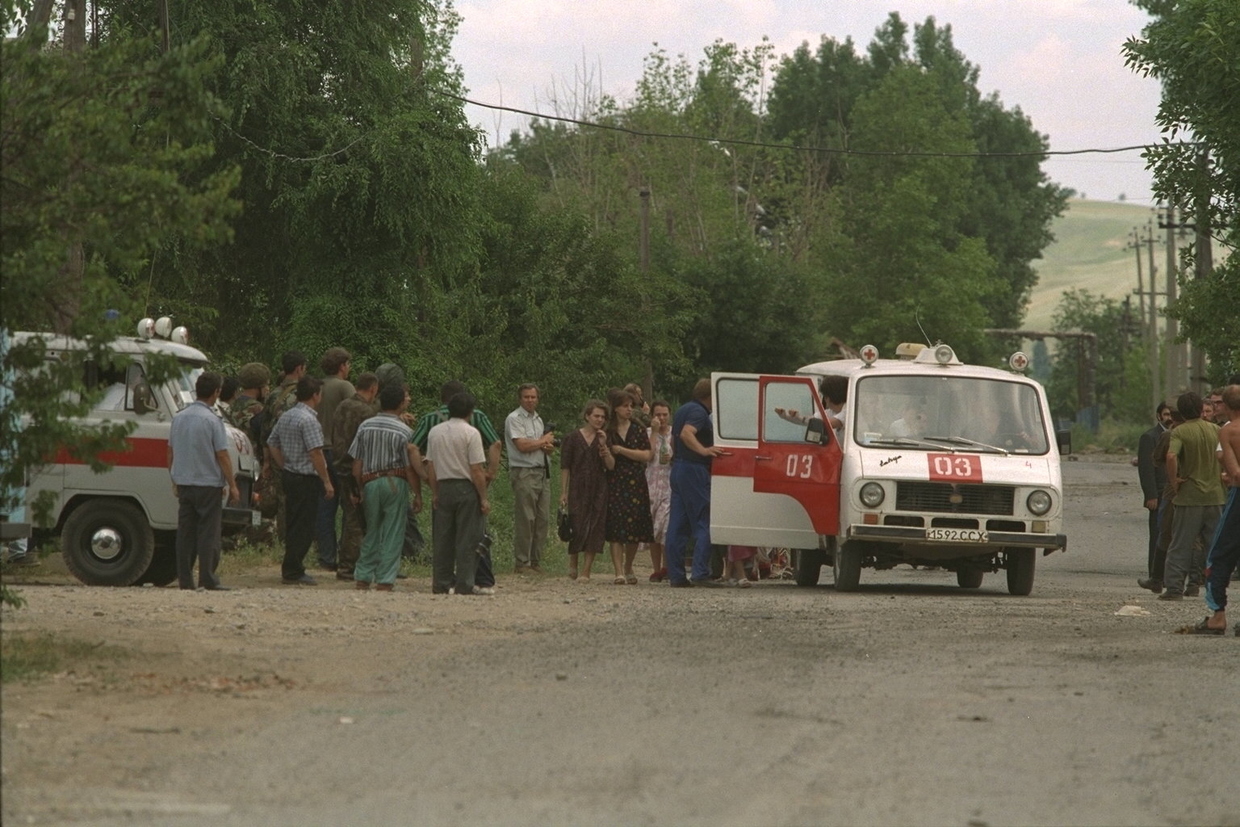
Budennovsk hostage taking. © Georges DeKeerle / Sygma via Getty Images
“We did everything we could. Pumped her body with everything we had. We would’ve saved her, but we ran out of drugs.”
The doctor didn’t remember the name right. It was Lena Kurilova, who was fatally wounded on her way to the store to buy some bread.
When the militants shot at people, it wasn’t just a cruel joke. The wounded were taken to the local hospital, while doctors and other medical professionals also rushed there along with the victims’ family members. The hospital was packed with people, and that’s where the terrorists went after their shooting spree in town. Nobody could stop them, of course. The doctors, patients, and other people became hostages.
Basayev shot everyone who he thought could fight back – captured police officers and soldiers, along with two teenagers who looked like they had some military training, or so the terrorists thought. Anton Kalinovsky and Vasily Sverdlik weren’t patients – one had come by to pick up some medical records for his university, and the other was there to see his mom who was a nurse and to share the good news about successfully passing his exam with her. Aleksandr Duvakin was also shot – his wife was taken hostage, and he went to the hospital to be near her, but the terrorists thought he was a spy. The doctors saved some of the police officers from execution by hiding their uniforms and papers during the first chaotic moments. Ironically, a local thug and the female officer who had just arraigned him ended up in the same room together. She thought he would give her up, but he didn’t.
READ MORE: Victims of Budyonnovsk siege remembered
Basayev soon voiced his demands, both strategic (recognizing Chechnya’s independence and pulling the troops out of the republic) and the more immediate ones (giving access to journalists). When the reporters didn’t come, he shot a few hostages. After that, several members of the press were brought in.
Meanwhile, army units and special forces were arriving in Budyonnovsk. Top officials led the task force – Director of the Federal Security Service Sergey Stepashin, Minister for Ethnic Affairs Nikolay Yegorov, and Minister of Internal Affairs Viktor Yerin. Unfortunately, they didn’t know anything about dealing with terrorists, and the task force was bogged down by unproductive meetings.
However, Alfa and Vympel teams trained in counterterrorism also arrived in Budyonnovsk. These were elite Russian special forces units, but there had been concerns regarding their loyalty after 1993, when President Boris Yeltsin and Vice President Alexander Rutskoy waged a small civil war in central Moscow. Alfa and Vympel officers refused to serve as an instrument of political killings at the time, saving their reputation but losing the trust of President Yeltsin, who ended up winning. As a result, Vympel was undergoing a humiliating reorganization process with many officers forced into retirement, while Alfa received a new commander. The worst thing was the fact that now these anti-terrorism experts were the last people the leadership was going to turn to for advice.
The task force was preparing to storm the hospital. The special forces made their calculations, stating that storming the building would result in mass casualties among hostages and soldiers. But the task force wouldn’t budge – they were going to storm the place.

250 Chechen militants attacked a hospital in Buddenovsk after first attacking a police station, taking around 2,500 victims hostage. © Georges DeKeerle / Sygma via Getty Images
The operation was a mess. The special forces units gave instructions to the soldiers and cops holding the perimeter in private conversations, while trying to get a map of the facilities for their team. The witnesses didn’t have anything encouraging to report. Basayev set up a fortress in the hospital building, with 1,500 hostages inside.
Many were shocked by the chaos around the hospital. Basayev enjoyed his time on the screen, gave interviews, and demonstrated his resolve to finish what he started. Journalists kept coming and going. At one point, a soldier holding the perimeter who had already been going mad just shrugged his shoulders and told one of the reporters who asked if he could get in, “It’s your life, go if you want to.”
The attack was launched on June 17. But with government officials, not counterterrorism specialists, in charge, many important factors were not taken into account. For example, ambulance doctors received no radio silence instructions and openly discussed the planned attack. The armored vehicle drivers, regular soldiers, began to warm up their APCs. It didn’t occur to them that the roaring engine sounds would alert the terrorists.
The attack would have failed anyway, even if these details had been considered. Alfa snipers were the only ones shooting to kill. Everyone else – Alfa, Vympel, and other special forces soldiers – didn’t want to hit hostages and were shooting at walls between windows and an empty room to create a psychological effect. Naturally, it didn’t intimidate the terrorists. They placed hostages in the windows, and the people screamed, “don’t shoot!” One terrorist forced a woman to stand in the window while he organized a firing position between her feet. An Alfa operative was able to get close to this thug and shot him dead – but clearly, the operation itself was doomed. The only positive outcome was when a few hostages were able to escape in the chaos. The terrorists also threw grenades, and several hostages were killed or wounded by the shrapnel because they were leaning from the windows.
A shell-shocked woman fell out of a window and just kept walking while bullets were flying around. Another hostage, a teenager, escaped by climbing a rainwater pipe. He was caught by an armored vehicle sent by spetznaz.
Very soon, it became obvious that the attack could not go on. Three Alfa officers and one policeman were killed, an armored personnel carrier burned, and over 20 soldiers were wounded. There was still a chance for the special forces to get to the first floor, but the units would have to get through hallways filled with hostages and terrorists shooting from behind their backs. However, the militants also lost about 10 people in sniper fire, and they were getting restless.

Read more
After 2pm, the terrorists let mothers with babies go free. The special forces retreated at this point, having done everything that could have been done without more casualties. The attack had already claimed several lives, wreaking havoc on the poor hostages.
The failed attack completely demoralized the task force. They had no idea what to do after that. The next day, Russian human rights activists and Prime Minister Viktor Chernomyrdin joined the negotiations. Because of a bad connection during one of the conversations, Chernomyrdin, while on camera, said, “Shamil Basayev, speak louder.” This phrase addressed to the terrorist became an unfortunate symbol for the tragedy.
Basayev finally adjusted his initial demands. He forced the Russian authorities to play his game and could now reap the benefits. Basayev demanded peace talks and buses so he and his group could go back to Chechnya. He took about a hundred people who volunteered to be his hostages during the retreat – journalists, politicians, and public figures.
Nobody attacked the terrorists on their way to Chechnya, and many experts agreed that this was the fatal mistake – instead of storming the hospital and causing unnecessary deaths, the negotiators should have made big promises. Then they could give the buses to the terrorists and get them during the retreat when they had fewer hostages and no fortress.
Tamara Sokolova, the nurse whose husband was wounded on the first day, shared what she saw when she finally left the hospital after staring down the barrel of a gun pointed at her for several days,
“People, the town residents, were waiting for us, they lined up from the hospital gate and all the way to the central street. Everyone had something for us – homemade drinks, pastry. They came to bring us food and water. Three days later, we were back rebuilding the hospital. Blood was everywhere, the air had a terrible smell. My colleagues and I rebuilt the hospital from ground zero in one year.”
One hundred and fifty were killed in Budyonnovsk: 14 soldiers, 18 police officers, and the rest of the victims were civilians.
When Basayev’s group reached Zandak, a village in Chechnya, the terrorists let the hostages go and disappeared in the mountains.
Talks with the warlords began and lasted three months. The terrorists used that time to recuperate, recruit new followers, and take back several Chechen towns and villages. Budyonnovsk inspired them by proving their strategy and methods effective. Budyonnovsk was truly the decisive battle of the Chechen War, and Russia lost it.
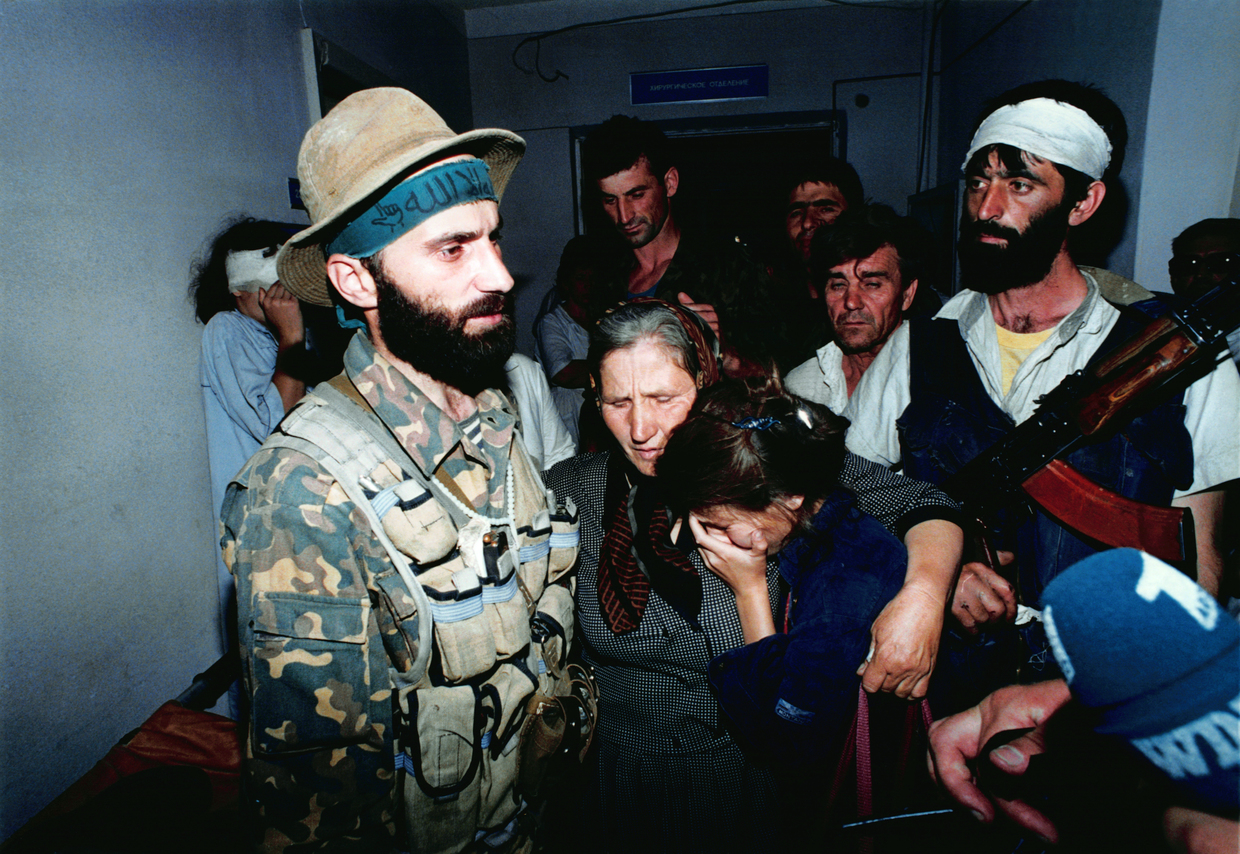
Shamil Basayev during the hostage-taking by Chechen rebels at the Budennovsk hospital on June 18, 1995, Russia. © LASKI / Gamma-Rapho via Getty Images
Sadly, the Budyonnovsk terrorist attack would not be the bloodiest in Russia’s history. The Beslan tragedy beat the ‘record’ in 2004. However, Budyonnovsk was a defining moment in many respects. The terrorists were able to change the course of the war when they had almost lost. And they saw that by organizing a hostage crisis, they could gain a tactical advantage, which resulted in a decade of similar attacks – Kizlyar in 1996, taking people hostage in a Moscow theater in 2002, and then Beslan, the most horrifying, heinous terrorist disaster in Russia’s history. The juggernaut was finally stopped after that.
The Budyonnovsk terrorist attack was also very significant for Russian society, as the events that followed cemented certain patterns in people’s minds and informed decisions made by politicians and generals. The resolve to destroy the terrorists in the Caucasus no matter the cost, zero tolerance when it comes to Islamist terrorism, the desire to see a powerful state – all of these are symptoms of the ‘Budyonnovsk trauma’. In 1995, Russians saw their country as weak and incapable of defending itself and its people. With time, the humiliation formed the aspiration to win – Russians now want to be victorious in every fight, no matter the cost.
By Evgeniy Norin, a Russian historian focused on Russia’s wars and international politics


